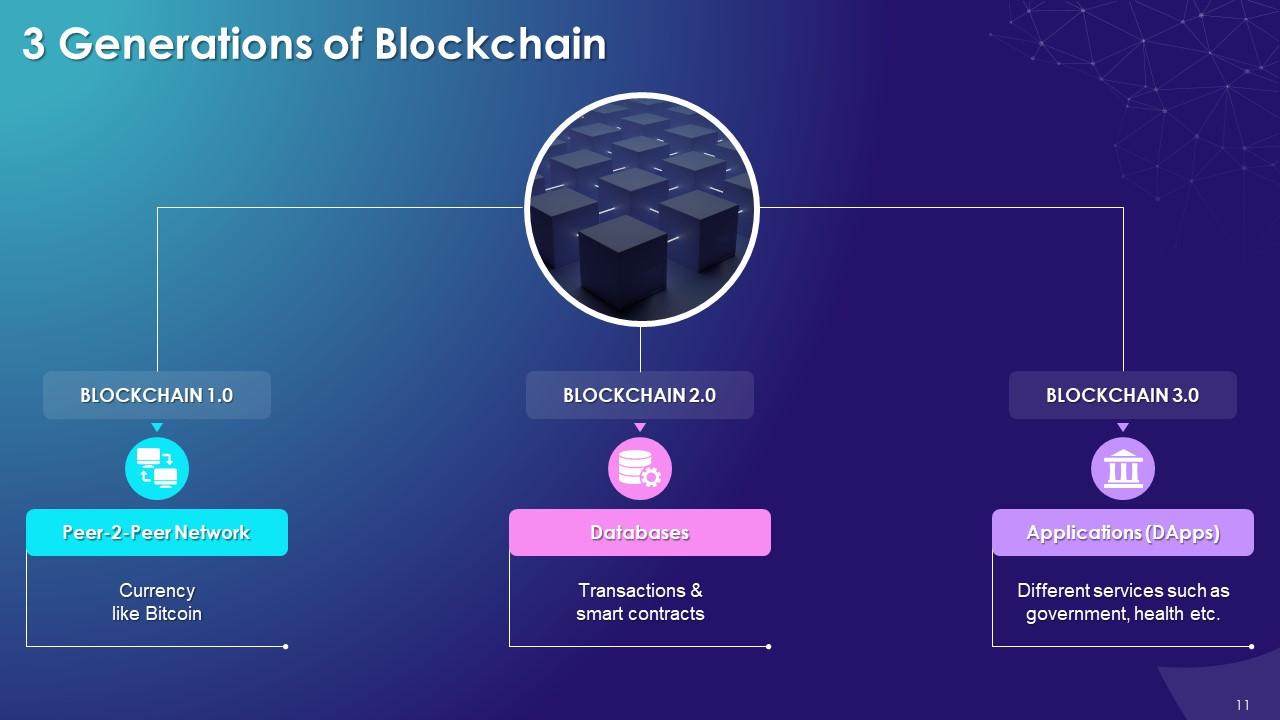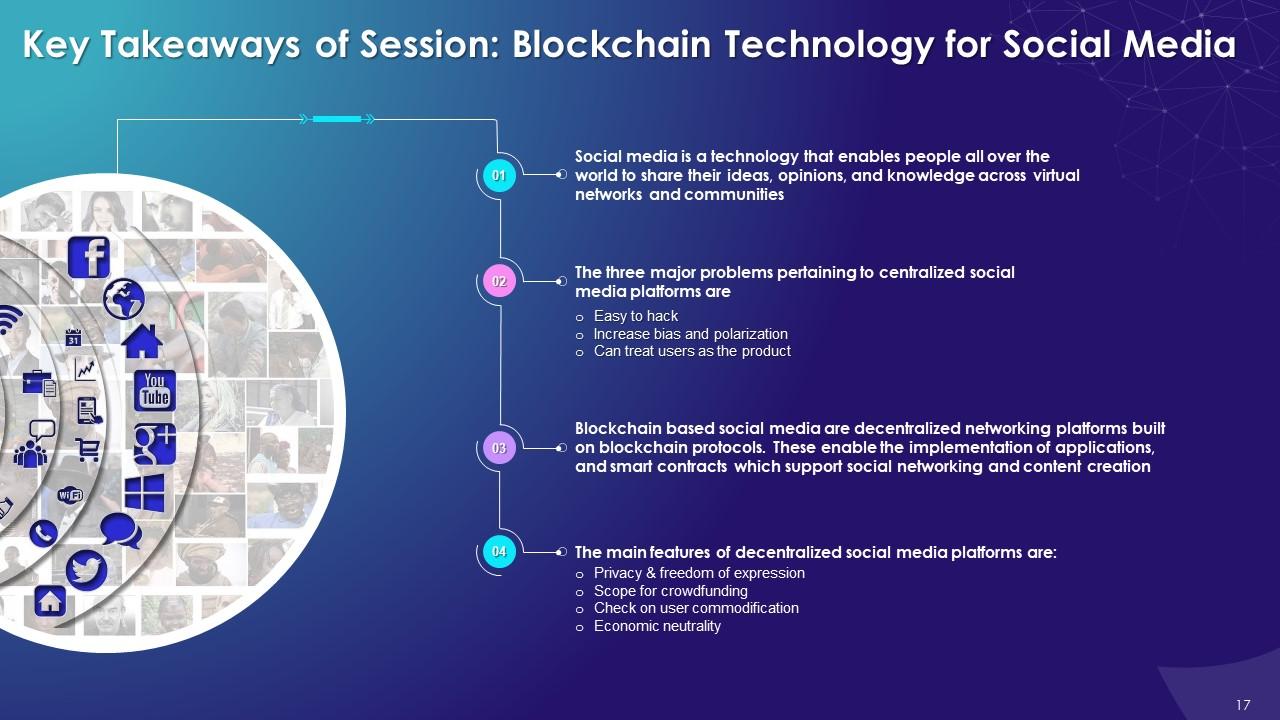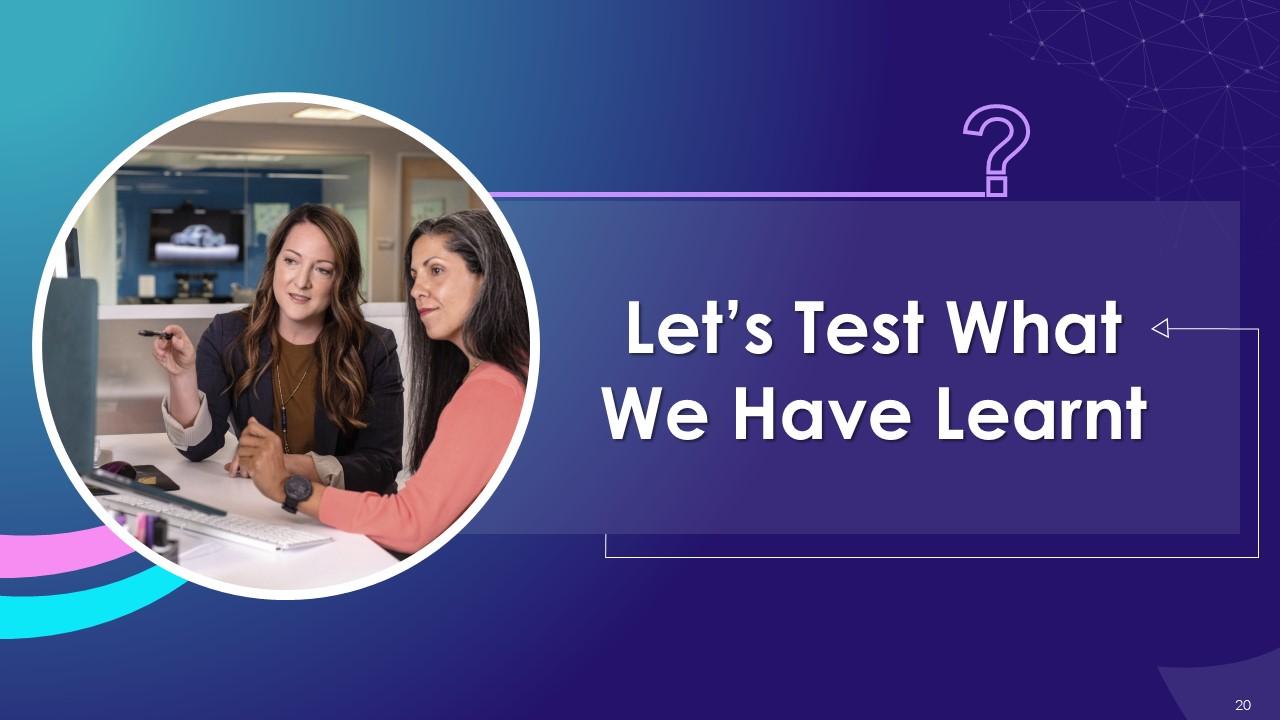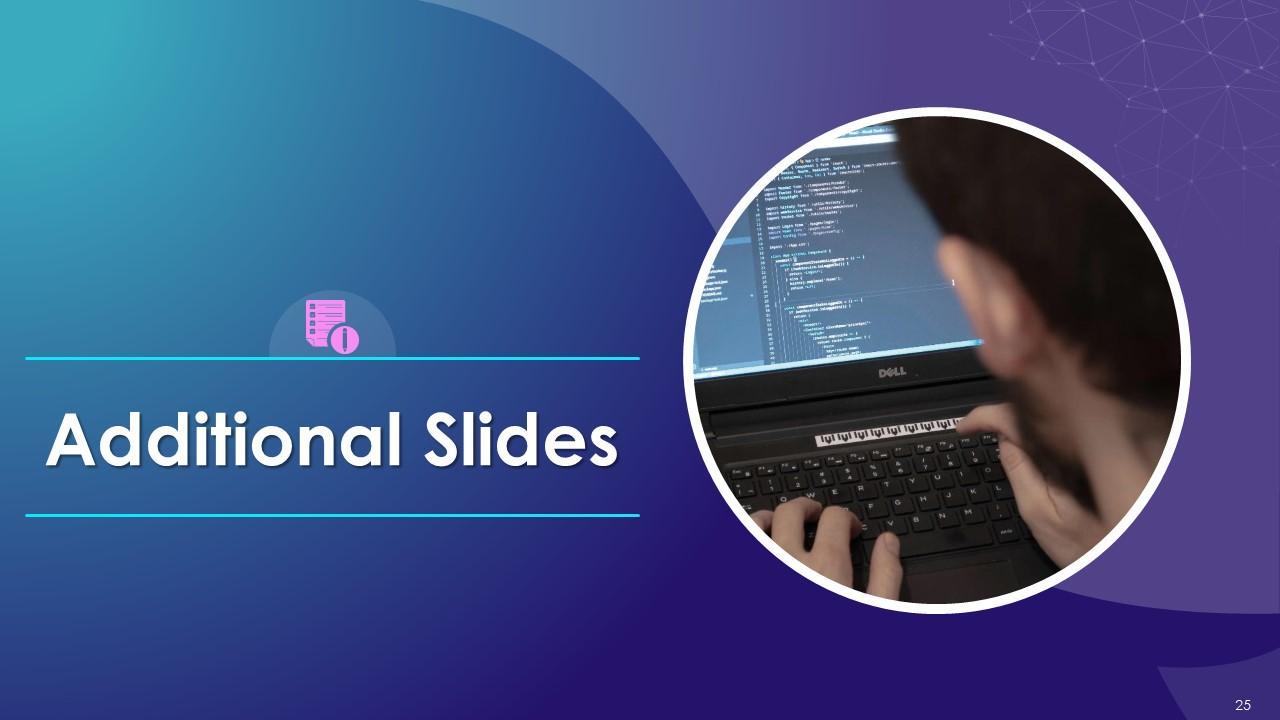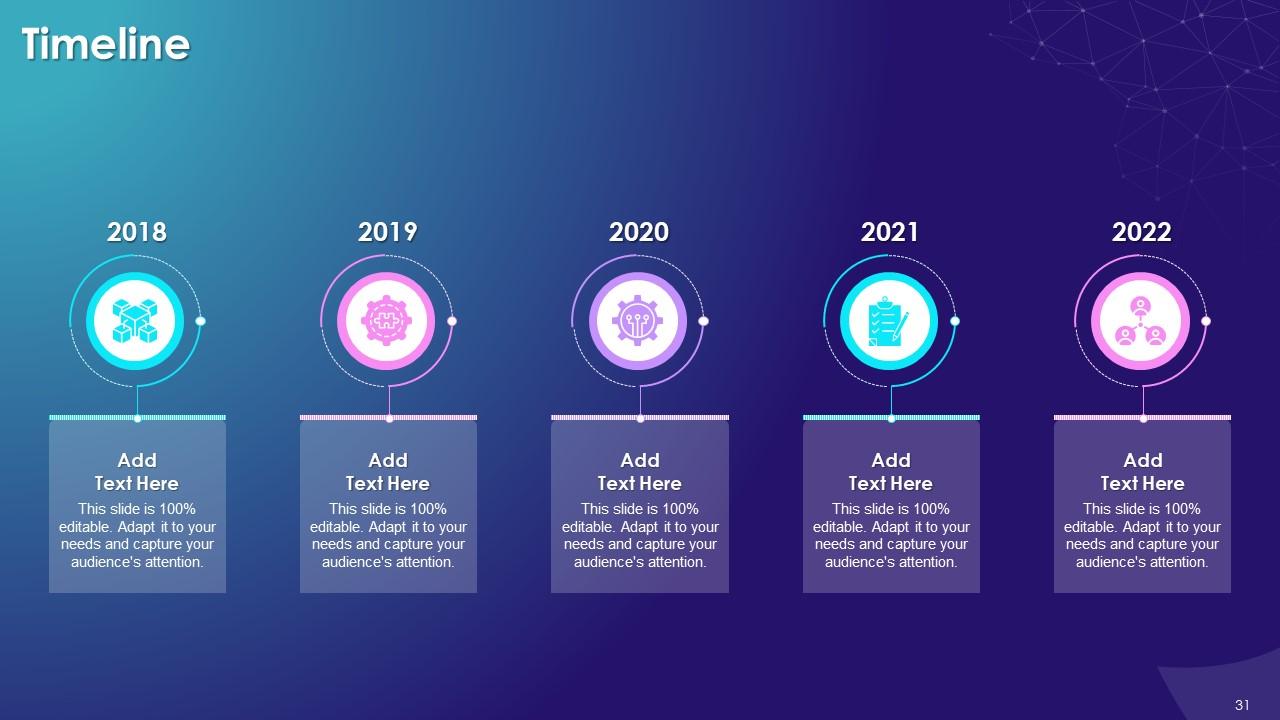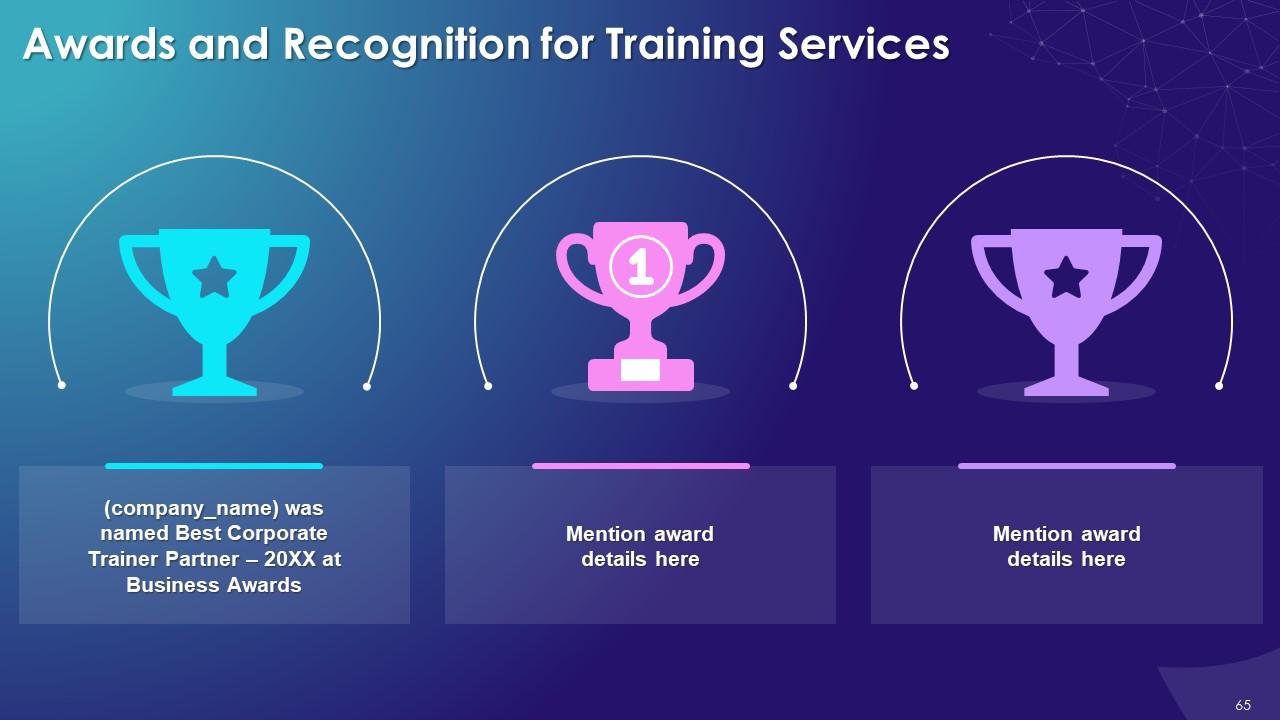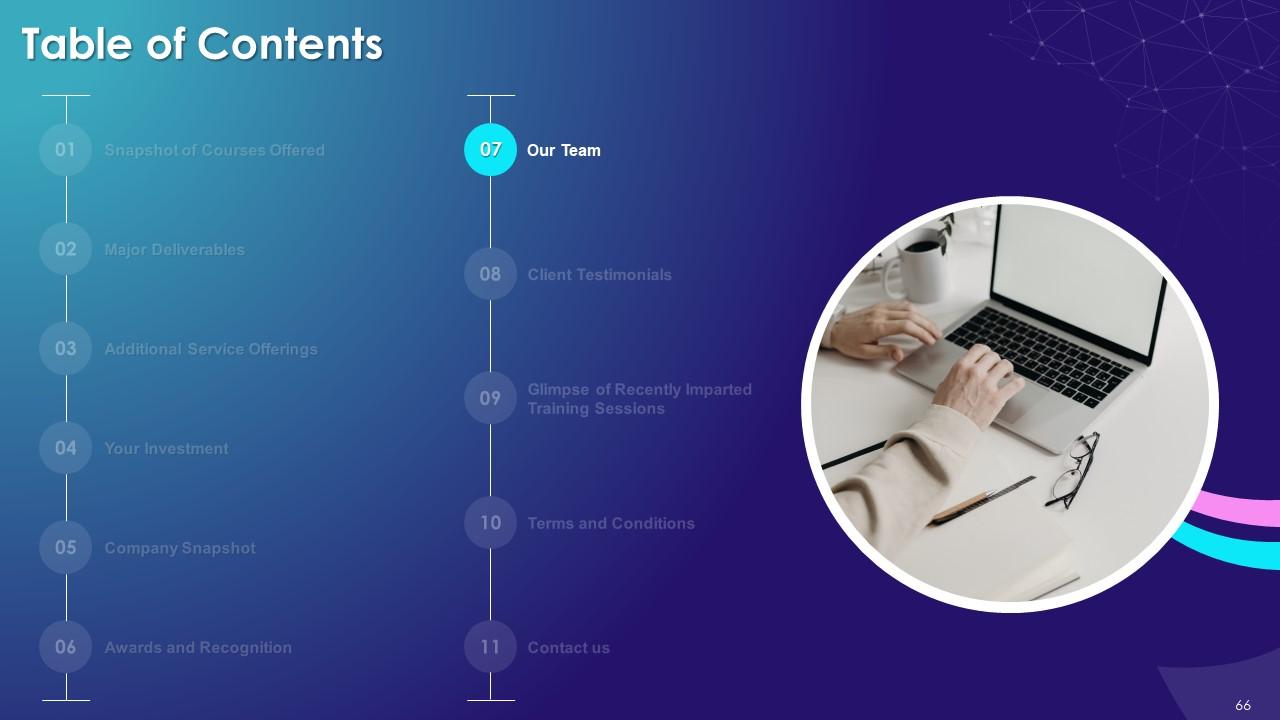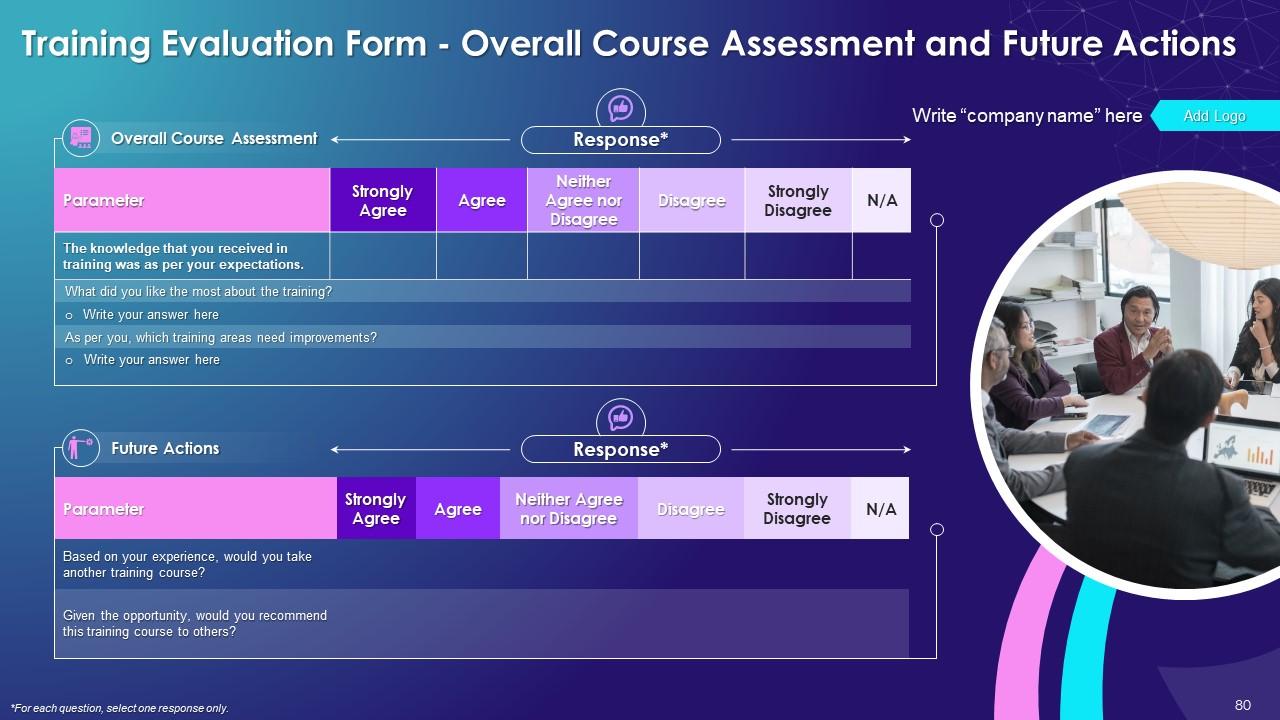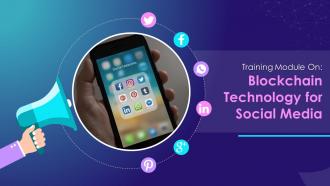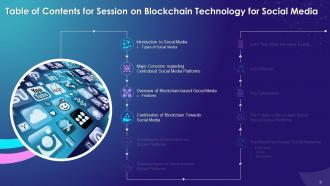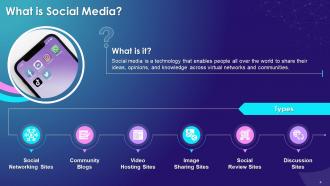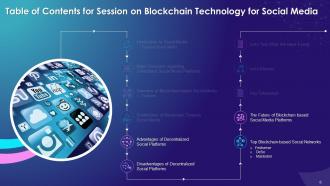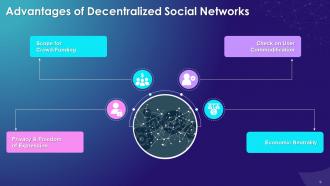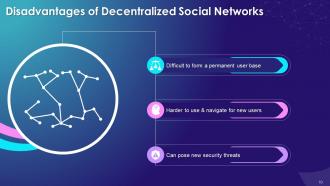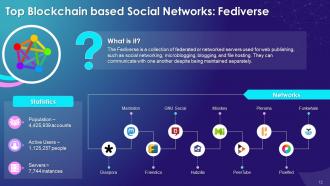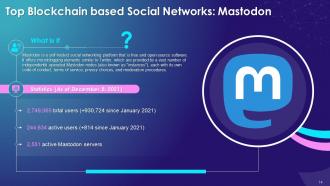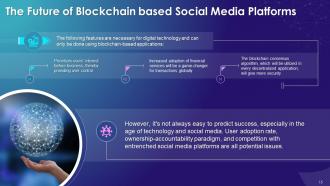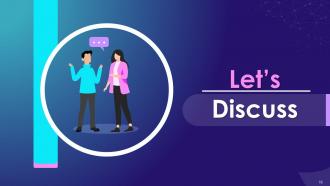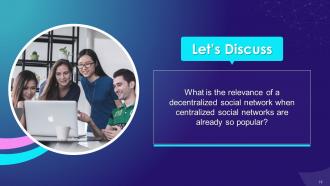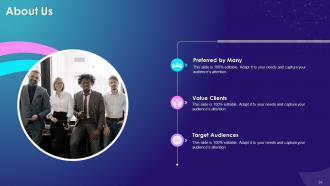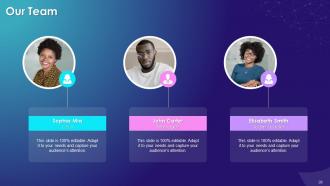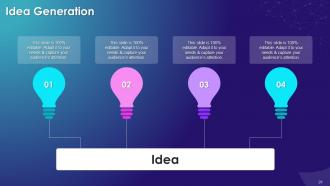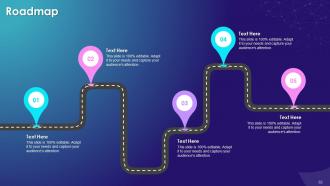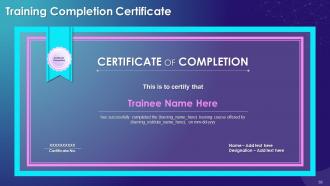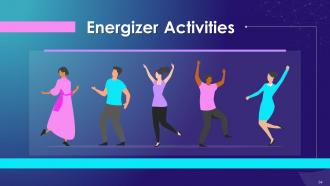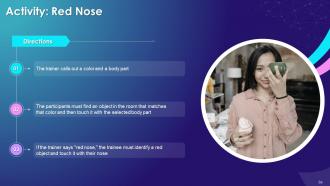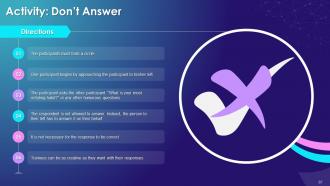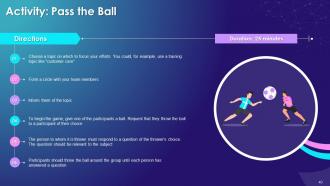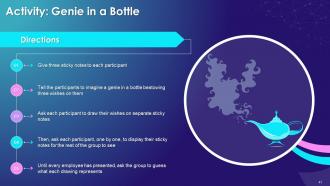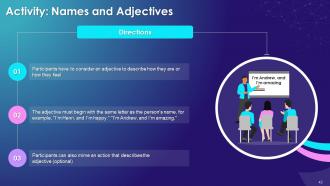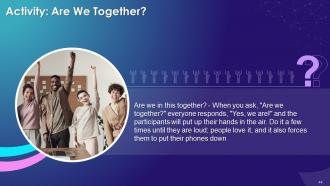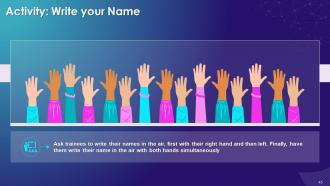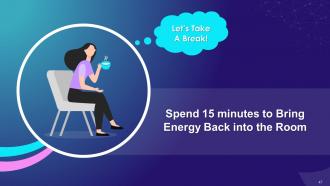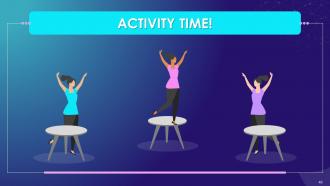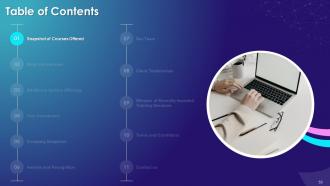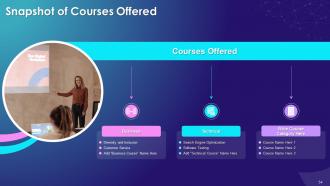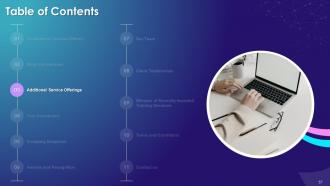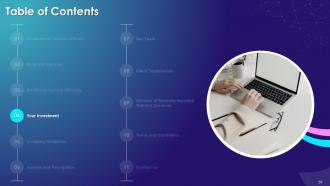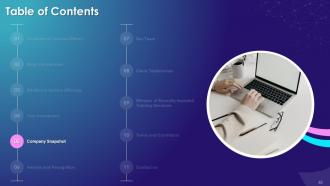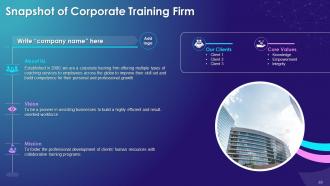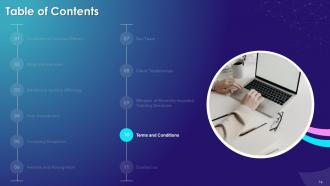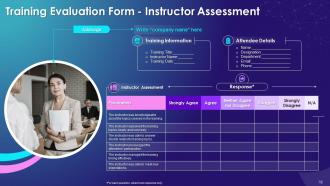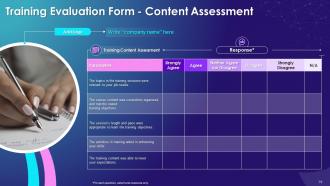Blockchain Technology for Social Media Training Ppt
This PowerPoint training module covers the applicability of blockchain to make social media platforms more decentralized. It covers the major concerns regarding centralized social media platforms, which are easy to hack, biased, and polarization. Further, it covers how blockchain helps create decentralized social media platforms with open-source code, decentralized control, and democratic decision-making. It also includes PPT slides on top blockchain-based social networks Fediverse, DeSo, and Mastodon. The PowerPoint module also has key takeaways, discussion questions, and MCQs related to the topic to make the training session interactive. It also includes additional slides on about us, vision, mission, goal, 30-60-90 days plan, timeline, roadmap, training completion certificate, energizer activities, detailed client proposal, and training assessment form.
You must be logged in to download this presentation.
 Impress your
Impress your audience
Editable
of Time
PowerPoint presentation slides
Presenting Training Session on Blockchain Technology for Social Media. This presentation deck contains 80 plus well-researched and uniquely designed slides. These slides are 100 percent made in PowerPoint and are compatible with all screen types and monitors. They also support Google Slides. Premium Customer Support available. Suitable for use by managers, employees, and organizations. These slides are easily customizable. You can edit the color, text, icon, and font size to suit your requirements.
People who downloaded this PowerPoint presentation also viewed the following :
Content of this Powerpoint Presentation
Slide 4
This slide defines social media technology and its various types such as social networking sites, community blogs, video hosting sites, image sharing sites, social review sites and discussion sites.
Instructor’s Notes:
What is it: Social media is an internet-based platform that gives people a platform to share personal details, documents, videos, and pictures digitally. People communicate with social media using web-based software or applications on a computer, tablet, or smartphone.
Types:
- Social networking sites: Facebook, Twitter, and LinkedIn are all social networking services that most people are familiar with. Friends, relatives, and brands can all be reached through these networks. These value intimate, human-to-human engagement and encourage knowledge sharing
- Community blogs: Community blogs are primarily websites where a large number of writers can post journal entries at a single location and where readers can respond to the posts by leaving comments on the blog
- Video hosting sites: YouTube is a major video hosting site that aids creators in bringing together content and sharing it on a platform that is suited for streaming. Because of its accessibility, video has become a very essential medium
- Image sharing sites: Images, animations, and drawings, capture our hearts, eyes, and imaginations. People create, curate, and share one-of-a-kind photos that can stimulate conversation
- Social review sites: Yelp and TripAdvisor, for instance, present evaluations from members of the public for a variety of destinations and activities. This eliminates a lot of the guesswork involved in making a restaurant or a hotel reservation
- Discussion sites: Reddit and Quora are two discussion sites that are expressly meant to start a conversation. Anyone can pose a question or express an opinion, which draws together, individuals’ similar interests and curiosities
Slide 5
This slide illustrates three major problems pertaining to centralized social media platforms which are that these platforms are easy to hack, increase bias and polarization. The other major concern is that the users themselves are the product that such platforms work upon.
Instructor’s Notes:
- Easy to hack: When a corporation stores user data in a single location, any compromise of that system exposes massive amounts of data in one go. The question now appears to be when, rather than whether, a database will be hacked. Every corporation, every organization, and every individual is vulnerable
- Increases bias & polarization: A lot of us rely on our social media feeds for most of our news or connections to news stories. How our social media feeds display information is critical to our lives. Someone who is branded as a liberal will most likely view news stories vastly different from someone who is classified as a conservative. Occasionally, users do seek out biased news sources that support their point of view. To make a mindful decision to do so yourself is one thing; it's quite another to have your social media platform do it. What is even more of a concern is that this happens because its advertisers, which include media outlets, have recognized you as a specific type of person based on your likes and other information the platform has gathered, analyzed, and packaged about you
- Users are the product: Using centralized social media to link people is not a good idea. Advertisers aren't simply companies that want us to buy their products and services; they're also people who want us to think in a particular way about a political candidate or a social problem. Advertisers are the customer, and user data is the product, with centralized social media platforms like Facebook, Instagram, LinkedIn, Twitter, and YouTube
Slide 6
This slide introduces the concept of blockchain social media platforms which are decentralized and enable end-to-end encryption for every interaction.
Instructor’s Notes:
What is it: Since Blockchain social media platforms are decentralized, there is no central proprietary authority in-charge of all data. Rather, data is distributed across servers at each network node in a homogeneous and decentralized manner. These platforms support social networking, content sharing, and even blogging.
Slide 7
This slide lists solutions that blockchain brings to the problems in existing social media platforms. The solutions include open-source code, decentralized control, democratic decision making and explainable AI.
Instructor’s Notes:
- Open-source code: It is feasible to retain an open-source code using blockchain technology. This has the advantage of allowing you to inspect data algorithms
- Decentralized control: Blockchain technology allows the network to remove centralization. As a result, no single entity will be able to exert undue influence on the platform
- Democratic decision making: Everyone agrees that a democratic system is the best option. The adaptation of social media to a networked structure will actually allow this to happen
- Explainable AI: Incorporating blockchain into social networks and adopting explainable artificial intelligence (AI) could be a significant step forward in the digital transformation process. This system is capable of explaining the reasoning behind each decision
Slide 9
This slide illustrates the advantages of establishing a decentralized social network. The main features include privacy & freedom of expression, scope for crowdfunding, a check on user commodification, and economic neutrality.
Instructor’s Notes:
- Privacy & freedom of expression: Those in-charge of managing centralized social media sites have access to every activity, even private messages. This poses a severe threat to the users' privacy, among other things. Blockchain-based social media networks guarantee better anonymity and let users fulfill their right to express themselves freely thanks to its decentralized consensus methods.
- Scope for crowd-funding: Apart from non-monetary advantages, blockchain-based social media also provides material benefits. Users are rewarded for posting on most decentralized social networks. Like those in other blockchain ecosystems, such benefits are in the form of the network's native cryptocurrency. The process of using mechanisms comparable to token sales enables users to run effective crowdfunding campaigns.
- A check on user commodification: User data is currently one of the most profitable assets, and those who control data control data producers’ and consumers’ thinking, behavior, and other factors. Distributed social media systems eliminate the fear of user commodification due to their peer-to-peer connection, end-to-end encryption, and lack of third parties.
- Economic Neutrality: Economic neutrality is a must-have ideal for many people who use decentralized social networks. They want to be free of intrusive advertising and the risk it brings to their privacy. To keep operations running, they frequently employ a digital currency such as Bitcoin.
Slide 10
This slide talks about the disadvantages that decentralized social media platforms present. Some of the drawbacks include the difficulty to attract a permanent user base, maybe harder to navigate for new users, and the fact that it may give rise to new security threats.
Instructor’s Notes:
- Difficulty to form a permanent user base: These platforms will have a hard time attracting users' and developers' attention. Diaspora and FreedomBox, for example, had trouble establishing a long-term user base, and it's probable that new platforms will as well. Due to network effects, social networks, in particular, are difficult to bootstrap — we join these because our friends are there and not for ideological reasons such as decentralization
- Harder to use & navigate: Established social media sites have optimized their interfaces based on millions of user feedbacks, but new social media sites are typically tricky to navigate for new users
- Can pose new security threats: Decentralized networks, in general, enable anybody to join and do not associate accounts with real-world identities such as phone numbers. To ensure account security, these systems employ public-key cryptography. However, most users find managing public keys challenging, and developing software that is both cryptographically safe and easy to use is difficult
Slide 11
This slide depicts the 3 levels of blockchain, namely cryptocurrencies, smart contracts, and governance mechanisms.
Instructor’s Notes:
- Blockchain 1.0: Blockchain 1.0 enables financial transactions based on blockchain and is carried out using Bitcoin. This version is permissionless; thus, any participant can conduct a legitimate Bitcoin transaction. Currency and Payments are the most common applications
- Blockchain 2.0: Blockchain 2.0's most major contribution, heralded by the advent of Ethereum, is the creation of smart contracts, that are small computer programs that "live" in the blockchain. They are self-contained systems that perform autonomously under predetermined conditions, such as facilitating, verifying, or enforcing contract execution. Smart Contracts lower the cost of verification, implementation, arbitration, and fraud protection and allow for clear contract definition, which eliminates the issue of moral hazard
- Blockchain 3.0: The abbreviation DApp refers to a decentralized application that does not rely on centralized infrastructure. As it relies on decentralized storage and communication, most DApps execute their backend code on a decentralized peer-to-peer network, such as a blockchain
Slide 12
This slide presents the basic definition of Fediverse along with some statistics related to the number of accounts on it, the active users and servers. It also lists networks that are on the Fediverse such as Mastodon, Diaspora, Pleroma etc.
Slide 13
This slide explains DeSo, a decentralized social blockchain network.
Instructor’s Notes:
How does DeSo work?
- Token-based structure: DeSo is based on the Ethereum (ETH) blockchain and uses a token-based structure. This means that DeSo tokens can be traded between peers to pay for network microservices like content creation, tagging other users, commenting, and liking
- Token Curated Registries: These are the foundation of the DeSo Network. Token Curated Registries (TCRs) are lists that differ from ordinary lists in one crucial way. These give list members the ability to curate which items are allowed
Slide 14
This slide introduces the decentralized social media platform, Mastodon. It tells us what it is and gives some general statistics such as the number of total users, active users and mastodon servers.
Slide 15
This slide gives us an overview about what could happen with the decentralization of social media with blockchain technology in the future. The challenges that it may face and the reasons why it may be adopted.
Slide 17
This slide lists key takeaways from this training session on blockchain-based social media.
Slide 35 to 49
These slides depict energizer activities to engage the audience of the training session.
Slide 51 to 77
These slides consist of a client training proposal highlighting what the company providing corporate training can accomplish for the client.
Slide 78 to 80
These slides highlight the training evaluation form for instructor, content, and course assessment.
Blockchain Technology for Social Media Training Ppt with all 85 slides:
Use our Blockchain Technology for Social Media Training Ppt to effectively help you save your valuable time. They are readymade to fit into any presentation structure.
-
SlideTeam just saved my project! Thank you so much. The variety of templates helped me showcase multiple perspectives easily.
-
This design is not only aesthetically pleasing but it has many uses making the cost worthwhile. The graphics look stunning, and you can edit them as per your needs.













